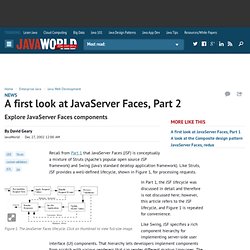

Tech Talk: 3 easy steps to self-sign a Applet Jar file. Jsoup Java HTML Parser, with best of DOM, CSS, and jquery. Pankil Patel « Enlightensoft's Blog. JSF. Tutorials for Maven, Scala, Spring, Struts 2, HTML5, ANT, iBATIS, log4j, Hibernate, JSP, JAVA, JDBC, AJAX, WAP, SQL, MySQL, C/C++, PERL, PHP, Ruby, Ruby on Rails, Python, HTML, XHTML, CSS, CGI, Shell, Unix, JavaScript, jQuery, Radius, UML, GPRS, GSM,i-Mod.
Add Restrictions.sqlRestriction to Criteria : Criteria « Hibernate « Java Tutorial. DevloperBook.com. Tomahawk DataScroller Introduction The t:dataScroller tag adds scrolling navigation to data components, such as t:dataTable and t:dataList.

Note : DataScroller must be nested inside of an UIData component, or attribute "for" must be given so that corresponding uiData can be found. The "row" attribute must be specified on the corresponding uiData. Tag Attributes Example As an example suppose we need to have list of car information to some of the entities in our application. SimpleCar.java DataScrollerList.java. Using Spring and Hibernate with WebSphere Application Server. Introduction The Spring Framework, commonly referred to as Spring, is an open source project that aims to make the J2EE™ environment more accessible. Spring provides a framework for simple Java™ objects that enables them to make use of the J2EE container via wrapper classes and XML configuration.
Spring's objective is to deliver significant benefits to projects by increasing development productivity and runtime performance, while also improving test coverage and application quality. Hibernate is an open source persistence and query framework that provides object-relational mapping of POJOs (Plain Old Java Objects) to relational database tables, as well as data query and retrieval capabilities. While many organisations are interested in discovering what benefits they can obtain from using these frameworks, IBM wants customers who do use them to know that they can do so with WebSphere Application Server in a robust and reliable way.
Back to top. Javascript Basics Part 6. This is the sixth in a series that will introduce you to the JavaScript language.

If you've read the previous 5 articles, you should have a good grasp on JavaScript by now. In this article we will be talking about the Document Object Model or DOM for short. The DOM is just a fancy term for "everything on your website". It includes every table, image, link, form field, etc. on your page. JavaScript allows us to manipulate any element on the page in real time. The first thing that you must understand is that as far as your browser is concerned, your HTML page is exactly the same thing as an XML document.
Dynamic datatable in jsf. The other day, I believe pompously declared that I'd never used an actionListener in JSF.
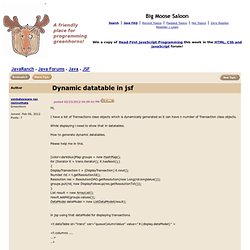
Which only goes to show that: 1. I'm senile 2. I'm an idiot ActionListeners are used far too often in places where they only make the app more complicated than it should be. JSF2 doesn't provide support for resolving rows within nested tables. In the mean time, we have to do something nasty. Here's an example: view plainprint? What this little horror does is obtain the ID attribute of the commandButton or commandLink that fired it and shred the ID string, picking out the outer and inner table indexes.
Public void doRemoveVessel() { SourceBlend sb = getSourceBlends().getData(ix1); if (ix2 < sb.getData().size()) { SourceVessel sv = sb.getData(ix2); sb.remove(sv); sb.recalc(); } } Google. MyFaces - Irian. First free JSF implementation Is an oustanding environment for development of web-applications. As co-founders of the MyFaces project we are a key player in developing user interfaces for web-applications. MyFaces is a project of the Apache Software Foundation, and hosts several sub-projects relating to the JavaServer™ technology. The Apache MyFaces project provides: Complete JavaServer™ Faces implementation Several component libraries containing UI widgets Extension packages to JSF Integration modules to other technologies and standards MyFaces Support We provide professional support for the usage of MyFaces in your company.
Html editor-2. /* * Licensed to the Apache Software Foundation (ASF) under one * or more contributor license agreements.
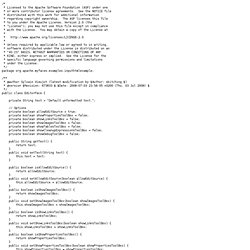
See the NOTICE file * distributed with this work for additional information * regarding copyright ownership. The ASF licenses this file * to you under the Apache License, Version 2.0 (the * "License"); you may not use this file except in compliance * with the License. Html editor-1. MyFaces -implimentation.
Java Forums at the Big Moose Saloon. Getting ipv4 remote address from FacesContext. Hi, I want the get a client's IP address from jsf.

With a little search effort, I could come up with this: view plainprint? HttpServletRequest httpServletRequest = (HttpServletRequest) FacesContext.getCurrentInstance().getExternalContext().getRequest(); String ip = httpServletRequest.getRemoteAddr(); HttpServletRequest httpServletRequest = (HttpServletRequest) FacesContext.getCurrentInstance().getExternalContext().getRequest(); String ip = httpServletRequest.getRemoteAddr(); How to get client's IP address, Domain using Java (JSP forum at JavaRanch)
Roseindia. Www.jsftutorials.net. Javajazzup.com. (Exadel) RichFaces - Open Source Rich JSF Components - jQuery Extension. Mkyong.com. JavaServer Faces (JSF) 2.0, is an MVC web framework which focus on simplifies building user interfaces (comes with 100+ ready UI tags) for Java web application and make reusable UI component easy to implement.
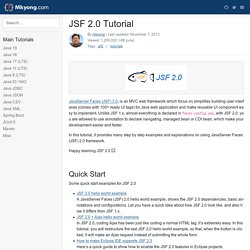
JavaWorld. A first look at JavaServer Faces, Part 1. Recently, I had the good fortune of training and mentoring a group of novice Java developers as we implemented a complex Web application using Struts, Enterprise JavaBeans (EJB), servlets, JavaServer Pages (JSP), and the JSP Standard Tag Library (JSTL).
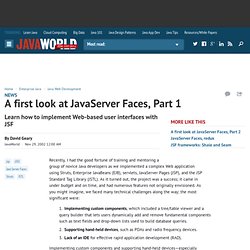
As it turned out, the project was a success; it came in under budget and on time, and had numerous features not originally envisioned. As you might imagine, we faced many technical challenges along the way; the most significant were: Implementing custom components, which included a tree/table viewer and a query builder that lets users dynamically add and remove fundamental components such as text fields and drop-down lists used to build database queries.Supporting hand-held devices, such as PDAs and radio frequency devices.Lack of an IDE for effective rapid application development (RAD). Implementing custom components and supporting hand-held devices—especially the latter—consumed a great deal of our time and effort. Example 1. <? A first look at JavaServer Faces, Part 2.
Recall from Part 1 that JavaServer Faces (JSF) is conceptually a mixture of Struts (Apache's popular open source JSP framework) and Swing (Java's standard desktop application framework).
